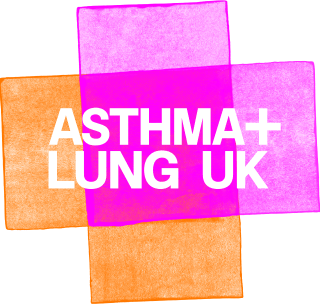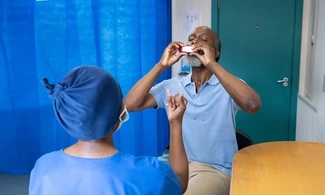Key takeaways:
- Access to basic care for asthma and COPD is far too low, and has got worse in recent years.
- Material deprivation and poor asthma control were strong indicators for hospital use, but over half of people think that better access to their GP would have kept them out of hospital.
- Nearly three-quarters of people faced a barrier to getting their diagnosis.
- Pollution is a real concern for people living with lung conditions, with over three-quarters of people saying air pollution has an impact on their life.
Our methodology
How we ran the survey
The survey was open from January to March 2025 for all people living with a lung condition.
We promoted the survey via our mailing list, website, and social media.
We asked over 70 questions including standard questions around basic care levels used in previous surveys. We also asked specific questions on topics such as housing, wood burning stoves, and Targeted Lung Health Checks.
We received 9438 responses in total.
The survey does have some limitations: it is self-selecting for those who want to share their experience and therefore more likely to be more informed about their lung condition. It is an online only survey which means those who are digitally excluded cannot respond. It is also quite a long survey length which could be a barrier to those with lower health literacy. We are working to make sure that every year we reach even more people, from a wide variety of backgrounds, so we can truly reflect the experiences of all people living with lung conditions.
Who took part?
More than 70% of respondents were women, and over 96% identified as white. Most respondents were aged 60-79 and had either asthma or COPD.
Our findings
Work and money
About a third of our survey respondents have a household income below £20,000. Only 24.9% of respondents were currently working, with 3.9% on leave and 8% unemployed.
Worryingly, over 14% struggle to afford basic necessities (7.4% of respondents are classed as being in ‘severe material deprivation, and a further 6.7% in material deprivation).
16.6% of respondents said they struggle to afford to keep their house warm.
People are in poorer health
Our respondents are more unwell than the general population:
24% rated their health as “bad” or “very bad” (compared to 5% in the general population).
71.7% live with at least one other long-term condition.
The most common comorbidities are musculoskeletal (38.6% of those with comorbidities), Heart (22.3%), Digestive system (22.2%), Mental health (21.6%).
Breathlessness and loneliness
This year, we asked about loneliness for the first time. The results show a strong link: the worse your breathlessness is, the more likely you are to feel lonely.
Basic care is not good enough
Basic care for asthma should include an annual review, inhaler technique check and a written asthma action plan. It appears rates of people receiving this have plateaued with some variation in basic care being delivered across the UK. Across all nations, less than 40% of asthma patients are receiving the basics. This is too low.
There is some variation in basic care elements being provided across the UK, with an average of 32.2% more people receiving an annual review than an inhaler technique check. This is despite checking people can use their inhalers properly is a key part of the national guidelines for asthma care.
Indeed, our survey found that many annual reviews were suboptimal.
The fundamentals are being forgotten
People with COPD should receive ‘5 fundamentals’ of care:
- Offer treatment and support to stop smoking
- Offer pneumococcal and influenza vaccinations
- Co-develop a personalised self-management plan
- Offer pulmonary rehabilitation if indicated
- Optimise treatment for comorbidities
But our survey found an overall drop in the level of basic COPD care, from 9.4% in 2024 to 8.8% in 2025.
Some elements of the 5 fundamentals are being provided more effectively than others, for example, our data shows that personalised self-management plan rates are much lower than rates of offering flu vaccines.
Emergency hospital use
Just over a quarter (26.2%) of respondents used emergency or unplanned care in the past year. Material deprivation and poor asthma control were strong indicators for hospital use.
When asked what might have prevented hospital visits, most pointed to better access to appointments in primary care. Lots of people expressed interest in tools to help self-management like an app.
For all people with lung conditions who went to hospital, 37.5% had a follow up within 2 working days. A further 14.1% had a follow up within 2 weeks of discharge. We can also see a slight improvement in levels of follow-up for people with asthma, though these levels are not good enough.
Delays in diagnosis
15.2% of respondents waited over a year between first discussing their symptoms with a clinician and getting a diagnosis, and nearly three quarters (73.4%) reported facing some kind of barrier to diagnosis.
Respondents have been finding the lung cancer screening programme (previously known as Targeted Lung Health Check) valuable. 85.5% of those invited to attend a TLHC attended. 44.9% got a new diagnosis. 74.8% found it worthwhile.
Pulmonary Rehabilitation works, but people struggle to access it
Among those eligible for pulmonary rehab (PR), only half (50.8%) had completed the course, yet nearly all who did found it helpful (85.6%). The main barrier given for not accepting a course of PR was other medical problems making PR too difficult for them.
Smoking and Vaping
While only 5.3% of respondents currently smoke or vape, nearly half (49.5%) are ex-smokers. 54.8% of ex-smokers had accepted NHS support to stop smoking, and of those who had used stop smoking services, 35.2% said it helped them stop smoking, with 25.8% saying it was too early to say
47.8% report that cigarette smoke triggers their lung condition, and 30.6% say the same about vaping.
Vaccinations
Most people who responded to our survey got their flu jab (85.1%). A small group of respondents had concerns about vaccination.
Of those who thought they were eligible for an RSV vaccine, 60.8% received it—but awareness is still too low, with only half of people (53.8%) having even heard of RSV.
Homes are harming health
Our respondents told us that keeping their house consistently warm is a challenge. The biggest reason for this was the high cost of energy (75.3%). Lots of people also said there were problems with their houses being draughty by design (19.6%). Tenants in social/council housing faced the biggest challenges.
One third (31.7%) told us that they had issues with either damp, mould or condensation, with winter being the most challenging season for over 90% of those with condensation, damp and mould in their home. Those renting are twice as likely to say that their home is harming their lung health than those who own their house.
The ongoing impact of air pollution
Nearly half of respondents (49.9%) told us that their lung condition is triggered by air pollution, and 79.2% said air pollution makes their health worse. Over three quarters of respondents reported air pollution having an impact on their life; this included things like avoiding outdoor exercise, having to stay indoors, or even having to move house because of air pollution. It was pollution caused by road transport that concerned our respondents most.
41% of respondents support stronger policy measures to curb air pollution, but 7.1% of respondents didn’t know that air pollution could harm your health.
What’s next?
We’re going to fight to make sure that people living with lung conditions get better access to the care they need, breathe clean air, and live in safe, warm homes.
You can sign up to hear more about our work and how you can help us fight.
If you have any questions about the data presented, please contact policy@asthmaandlung.org.uk










